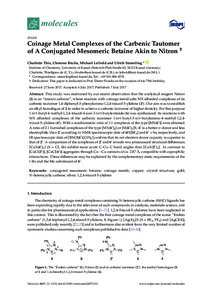| dc.date.accessioned | 2018-01-31T13:54:53Z | |
| dc.date.available | 2018-01-31T13:54:53Z | |
| dc.date.issued | 2017-07-07 | |
| dc.identifier.issn | 1420-3049 | |
| dc.identifier.uri | urn:nbn:de:hebis:34-2018013154265 | |
| dc.identifier.uri | http://hdl.handle.net/123456789/2018013154265 | |
| dc.description.sponsorship | Gefördert durch den Publikationsfonds der Universität Kassel | |
| dc.language.iso | eng | |
| dc.rights | Urheberrechtlich geschützt | |
| dc.rights.uri | https://rightsstatements.org/page/InC/1.0/ | |
| dc.subject | conjugated mesomeric betaine | eng |
| dc.subject | coinage metals | eng |
| dc.subject | copper | eng |
| dc.subject | crystal structure | eng |
| dc.subject | gold | eng |
| dc.subject | N-heterocyclic carbene | eng |
| dc.subject | silver | eng |
| dc.subject | 1,2,4-triazol-5-ylidene | eng |
| dc.subject.ddc | 500 | |
| dc.title | Coinage Metal Complexes of the Carbenic Tautomer of a Conjugated Mesomeric Betaine Akin to Nitron | eng |
| dc.type | Aufsatz | |
| dcterms.abstract | This study was motivated by our recent observation that the analytical reagent Nitron (2) is an “instant carbene”, whose reaction with coinage metal salts MX afforded complexes of its carbenic tautomer 1,4-diphenyl-3-phenylamino-1,2,4-triazol-5-ylidene (2′). Our aim was to establish an alkyl homologue of 2 in order to achieve a carbenic tautomer of higher donicity. For this purpose 1-tert-butyl-4-methyl-1,2,4-triazol-4-ium-3-tert-butylaminide (6) was synthesized. Its reactions with MX afforded complexes of the carbenic tautomer 1-tert-butyl-3-tert-butylamino-4-methyl-1,2,4-triazol-5-ylidene (6′). With a stoichiometric ratio of 1:1 complexes of the type [MX(6′)] were obtained. A ratio of 2:1 furnished complexes of the type [MX(6′)2] or [M(6′)2]X. 6′ is a better σ-donor and less electrophilic than 2′ according to NMR spectroscopic data of 6H[BF4] and 6′ = Se, respectively, and IR spectroscopic data of [RhCl(6′)(CO)2] confirm that its net electron donor capacity is superior to that of 2′. A comparison of the complexes of 2′ and 6′ reveals two pronounced structural differences. [CuX(6′)2] (X = Cl, Br) exhibit more acute C‒Cu‒C bond angles than [CuX(2′)2]. In contrast to [CuCl(2′)], [CuCl(6′)] aggregates through Cu···Cu contacts of ca. 2.87 Å, compatible with cuprophilic interactions. These differences may be explained by the complementary steric requirements of the t-Bu and the Me substituent of 6′. | eng |
| dcterms.accessRights | open access | |
| dcterms.bibliographicCitation | In: Molecules. - Basel : MDPI. - 2017, 22(7), 1133, 1-22 | |
| dcterms.creator | Thie, Charlotte | |
| dcterms.creator | Bruhn, Clemens | |
| dcterms.creator | Leibold, Michael | |
| dcterms.creator | Siemeling, Ulrich | |
| dc.relation.doi | doi:10.3390/molecules22071133 | |

